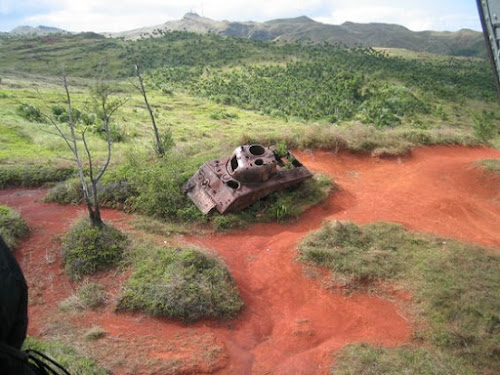Gun Beach.
Gun beach was a must-visit destination when I was a sailor stationed on Guam in 1971. The snorkeling was great, but the location was remote and difficult to get to. It involved a long hitch-hike from the Naval Communication Station at Finegayen.
Hitch-hiking was the main form of transportation for servicemen on the island back then. We never knew how long we'd have to wait but we could always count on a ride eventually. This was the main way that GIs got to meet Guamanians. It was safe, fun, and reliable.
Back to the narrative. We got dropped off at a two-track trail that wound through the jungle. At that point the "boonie-stomping" began. We were huffing and puffing, sweating, battling spiders and mosquitos the whole way. After a long, hot, and strenuous hike, we broke out of the jungle and found ourselves on the shoreline...but we weren't there yet, we still had a mile to go, navigating a shoreline that was as rocky as it was sandy. As I recall, we rounded a bend and saw in the distance the distinctive bluff that towered over Gun Beach.
Finally we were there.
A short breather was followed by getting into our trunks and gearing-up in our masks, fins, and snorkels. The water was the perfect temperature and crystal clear...typical for Guam. As we were inside the reef, sharks were never a problem.
While we were there I hiked around to find the gun for which the beach was named. It was easy to find...a rusting short-barreled, large caliber gun in a crumbling concrete and coral pillbox.
I swept away the spiderwebs and took a look inside. The pillbox wasn't impressive only because it was so tumble-down and filled with debris; nonetheless, it was evident that, in its heyday, this was a formidable fortification with a menacing gun.
For my Battle of Guam project, I want to connect it to as many of my own experiences as I can from my days on the island. To that end, I recreated a 1/32 version of the Gun Beach pillbox.
By the way, Gun Beach, like all of Guam, is considerably changed from my day:
The project began with the construction of the pillbox. I used sheet styrene throughout.
The most time-consuming component was the stepped-embrasure. I used the sheet styrene at right angles to all surfaces at the embrasure as well as the rear entrance to simulate very thick concrete walls.
I'm trying to do this project with materials that I have on hand...nowhere is this more evident than with the construction of the gun.
The gun barrel is part of a cast-off technical pen, and the recuperator is a piece of dowel.
The cheeks of the gun were laid out on a sheet of craft plywood and cut out with the scroll saw.
The next operation was at the drill press where I drilled out the holes for the trunnions.
Finding the center on the pedestal to drill a hole in which to mount the pintle.
I took a scrap of mahogany to the bandsaw to cut a square breech-block.
The elevation wheel is a spare road wheel from one of the Tamiya Chi-ha tanks that I've made for this project.
The finished product. I opted to apply a camouflage pattern to the portion of the barrel that protrudes from the embrasure.
I used hot glue to affix the gun to the floor of the pillbox, and with that, it was time to glue on the roof.
The rear entrance. To provide a textured finish, I painted the pillbox in Tamiya gray primer overall, and then with some Testors black spray paint, I stood back about two feet from the spray booth and applied a very light spray. I followed that with Tamiya haze gray in the same manner. I'm pretty happy with the result.
Looking into the pillbox from the back entryway.
For the finished project, the pillbox will be bermed into the styrofoam terrain, concealing much of it.
I will probably be making two more pillboxes, one will be a copy of the Agana channel machine-gun position, and the other will be one of the very small ones on Tumon Bay that I used to change into my swimwear.
Preparations like this will be going on for a long time before the battle begins.
Watch this space and...
Soldier on!

























































